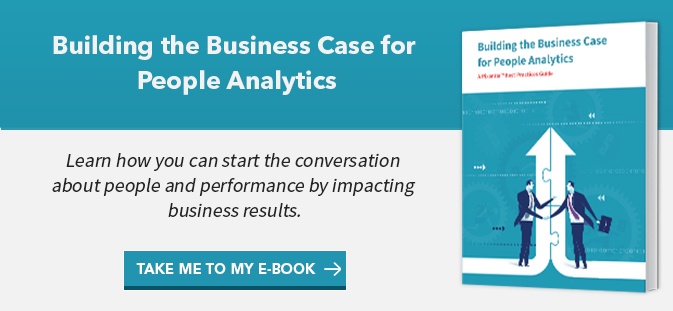
When the hype of people analytics hit us like a wave, it promised a wealth of new knowledge about people and work. Cloud talent management creates massive amounts of data, and visionaries told us some sort of nirvana awaited if we could gather all that data and analyze it.
Early adopters with the resources to do so created data lakes, hired analytics teams and embarked on a journey of discovery.
It stalled. Bersin by Deloitte’s Global Human Capital Trends 2015 report showed us that only 4% of companies could perform advanced people analytics. In their 2016 report, Bersin celebrated that growth in analytics had doubled—all the way to 8%.
Under the Radar
In the meantime, companies approached companies like ours with specific business problems they needed to solve. By resolving one issue at a time instead of taking on the entire people analytics world, they made significant gains that fueled more analytics investments.
They often saw productivity gains they didn’t expect. For example, a motorized recreational equipment company saw a problem with new hire turnover among in-store sales staff. Data analysis showed a strong correlation between training completion and turnover. The company instituted a self-directed training program with gamified motivational tools and automated tracking tools for managers. The gains in new hire turnover paid for their investment in a few months, but the biggest gain was in in sales. Well-trained employees were more engaged and knowledgeable about their products, and it showed up in top-line results.
The Current State of People Analytics
A 2016 report from the New Talent Management Network tells us the promise of big data breakthroughs in human capital management has not yet achieved widespread success. Most companies are still using analytics only for basic insights.
When NTMN asked if companies were using analytics, 85% answered in the affirmative, but the type of analysis they were doing shows a different picture. Most respondents could not predict future challenges and talent gaps. They were still stuck on basic turnover numbers and primary recruiting efficiency metrics.

The study cited two reasons HR organizations have not made significant progress.
- Poor data quality—65% of respondents said bad data hinders their efforts.
- Understaffed and inexperienced data teams—47% had no one dedicated to analytics, and 41% of those with data teams said they are a hindrance. [1]
As the study authors stated, the challenges their survey respondents face can be overcome. They recommend starting by asking business leaders what insights they want and how much they are willing to pay for them. They then offered a set of questions to ask their leaders to determine how data-driven they want to be and how they want to structure their analytics capability. Their final recommendation was to evaluate the capability and cost savings of a specialized contractor or consulting firm.
In our experience, the companies with the greatest success have two characteristics in common.
- HR is closely aligned with the business and tackles business problems in partnership with line-of-business leaders. While they do pay close attention to internal metrics, their focus is on organizational performance. They also realize that much of the data they need is outside of HR, and they develop initiatives that directly affect organizational performance.
- Realizing they do not have the expertise to pursue their goals, they team up with an experienced analytics partner and learn from them while they use their services. Data scientists, analysts, and data visualization specialist are expensive, and it can take years to get your team up to speed. An analytics partner, using the economies of scale that having many clients provides, will cost a fraction of hiring a dedicated team and will get much quicker results. A good partner will also know how to deal with dirty data.
You can get excellent results using the data you have right now. Whether you choose to build your own team or partner with a consulting firm, we recommend you work with your business leaders to solve the issues that keep them awake at night. They will sleep better, and so will you.
References:
1. “Still Under Construction: The State of HR Analytics 2016.” New Talent Management Network. 2016.
 PhenomᵉCloud is a comprehensive technology solutions provider committed to empowering businesses to overcome challenges, enhance their workforce capabilities, and achieve superior outcomes.
PhenomᵉCloud is a comprehensive technology solutions provider committed to empowering businesses to overcome challenges, enhance their workforce capabilities, and achieve superior outcomes.


Leave a Comment